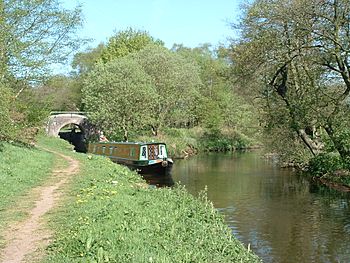River Churnet facts for kids
Quick facts for kids Churnet (Staffordshire) |
|
|---|---|

A narrowboat has just locked down into the Churnet river at Oak Meadow Ford lock
|
|
| Country | England |
| Region | Staffordshire |
| District | The Roaches, Leek, Churnet Valley |
| Physical characteristics | |
| Main source | The Roaches, Staffordshire Moorlands, Staffordshire, England 460 m (1,510 ft) |
| River mouth | Near Combridge, East Staffordshire, England |
The River Churnet is a river found in Staffordshire, England. It flows into the River Dove, which is another important river in the area.
Contents
The River Churnet's Name
The name "Churnet" has a mysterious past. No one knows for sure where it came from. People think it might be an old British name for the river. This name would have been used even before English was spoken in this part of the world.
Where the Churnet Starts and Flows
The River Churnet begins high up in the Staffordshire moorlands. Its source is over 460 m (1,510 ft) (1,000 feet) above sea level. This is near a rocky cliff called The Roaches, right by the A53 road that goes from Leek to Buxton.
Journey to the Sea
The Churnet's starting point is very close to Black Brook. Black Brook eventually flows into the Irish Sea through the Dane and Weaver. However, the Churnet takes a different path. It flows into the Dove, then the Trent, and finally reaches the North Sea through the Humber Estuary.
Through Towns and Valleys
After flowing downhill for a few miles, the river reaches Tittesworth Reservoir. This large reservoir provides fresh water to homes in the Potteries area and Leek. Once it leaves the dam at Tittesworth, the Churnet flows into the old market town of Leek. Here, the river's water was used until recently to help make dyes for the town's textile and silk industries.
South of Cheddleton, the river enters the beautiful Churnet Valley. This area is known for its ancient woodlands, many types of wildlife, and interesting industrial history.
River and Canal Join Up
The Caldon Canal connects with the river at Oak Meadow Ford Lock, about 2 miles past Cheddleton. For a while, the river and canal flow together as one waterway. They separate again at Consall Forge. The river then continues through the valley, passing old woodlands and the Bolton Copper works at Froghall. It flows through the villages of Oakamoor and Alton. Finally, it goes past the JCB factory at Rocester before joining the River Dove near the small village of Combridge.
Exploring the Churnet Valley
The section of the river from Cheddleton to Rocester runs through the scenic Churnet Valley. This part of Staffordshire is sometimes called "Staffordshire's Rhineland" or "Staffordshire's Little Switzerland." The valley features steep gorges and riverbanks, filled with lots of trees and wildlife. Several woods in the valley are looked after by the National Trust and the RSPB. These organizations help protect the natural beauty and animals of the area.
The Churnet's Industrial Past
The River Churnet has been very important to industries along its banks for almost a thousand years. Because of this, it was once considered one of the most polluted rivers in Europe.
How Industries Used the River
In Leek, the textile industry heavily used the river's water to make dyes. The dyeing business started there in 1734. People even claimed that the Churnet's water was the best in Europe for this purpose. In nearby Cheddleton, the river's power was used to run a flint mill. This mill ground down flint, which was then used in the pottery industry.
Further downstream, at Froghall and Oakamoor, the Thomas Bolton Copper works used the Churnet's power. They helped make the world's first transatlantic telegraph cables. However, the processes used to make copper wire at these sites caused a lot of pollution in the river.
Iron and Transport
The Churnet Valley was also a big center for the iron-smelting industry. Records show that iron was being smelted here as early as 1290. The river was the main source of energy for these early forges. Some of the first forges were near Oakamoor. An older forge still stands at Consall, right by the locks on the Caldon Canal.
The Caldon Canal runs alongside the river through the Churnet Valley. In some places, the river itself was made into a canal. In the past, there was a lot of freight traffic on the waterway. Boats carried limestone and ironstone from the wharves on the canal. Today, the only industrial use of the river is by a sand quarry at Oakamoor.
A Cleaner River Today
Since the decline of heavy industry in Leek and the Churnet Valley, the water quality has greatly improved. It has gotten so much better that a program is now underway to re-introduce salmon into the river. This shows how much the river has recovered!

